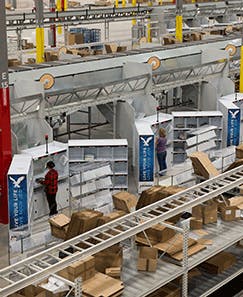Over the past decade, retailers have built direct-to-consumer e-commerce fulfillment centers, isolating inventory that was put there specifically to fill online orders. A decade later, a majority of retailers are still trying to establish a workable balance between e-commerce fulfillment and retail store replenishment. Retail executives are grappling with the logistics of omni-channel fulfillment and the myriad of issues that it can create.
Consumers moving across channels, from mobile to social networking, to the web and in-store, create complications for managing inventory, like crediting of e-commerce purchases that have been returned to stores. Within their distribution centers (DCs), employees are split between filling Internet orders and store replenishment, reducing worker efficiency.
For most retailers, online purchasing—particularly with ordering from mobile devices —– remains a strong growth area for their businesses, showing double-digit annual expansion. But fulfilling e-commerce orders demands more attention from retailers. Speed of delivery, a better customer experience, improving the management of inventory, and extending the workforce to handle both store replenishment and e-commerce orders are the factors that are driving retailers to adopt better omni-channel solutions.
A Better Solution for a Dedicated Omni-Channel Fulfillment Center
One major retailer that has taken up the challenge to streamline its omni-channel fulfillment is American Eagle Outfitters (AEO) (www.ae.com), a global specialty retailer offering high-quality, on-trend clothing, accessories and personal care products under its American Eagle Outfitters and Aerie brands. The retailer has recently gone live with its latest DC located in Hazle Township, Pa., designed specifically for handling omni-channel fulfillment for both its e-commerce orders and replenishment to its retail stores throughout the U.S.
This new, one million square-foot DC was designed to manage inventory and fulfillment 180-degrees differently from how omni-channel and e-commerce DCs have managed inventory and fulfillment over the past decade. To keep pace with the growing cross-channel purchasing by consumers, the Hazle Township DC's inventory and fulfillment processes are completely desegregated, making its inventory, picking and packing functions, and picking personnel 100% accessible for either e-commerce fulfillment or store replenishment.
"As with other retailers, omni-channel is a critical part of our business," says David Repp, vice president, North American distribution for American Eagle Outfitters. "We are seeing customers cross-shopping e-commerce and brick & mortar stores. This overlap caused us to rethink how we manage our inventory and fulfillment processes.
"E-commerce is a growth engine and our Ottawa, Kan., facility for processing e-commerce was getting close to capacity," continues Repp. "We decided to use it as an opportunity to examine our overall distribution network and found that we could reduce our inventory, operating costs and in-transit delivery time to our customers by combining our DC e-commerce and store inventory and fulfillment operations."
This was a critical motive that drove AEO in the direction of building the Hazle Township facility.
Before the build-out of Hazle Township, the company maintained two North American DCs, located in Warrendale, Pa., and Ottawa, Kan. It was the Ottawa DC that provided direct-to-consumer order fulfillment, as well as in-store replenishment for 45% of its store locations. From this DC, in-transit times for e-commerce orders averaged four to six days to AEO's customers.
Defining and Designing the Facility
In 2012, after a number of site assessments that analyzed DC locations based on the company's customer population, ordering profiles, inbound and outbound transportation, labor availability and labor costs, the final decision was made to locate the new omni-channel DC in Hazle Township, Pa., within the Harrisburg-Scranton corridor.
During the process of reviewing sites for the new DC, AEO selected fulfillment and DC specialists from Vargo (www.vargosolutions.com) to consult on site selection. But Vargo's main focus was to take the lead in defining and modeling the facility, to finalize designs for its size, processes and equipment, and manage the installation of the systems, testing and start-up to achieve a fully operational omni-channel order fulfillment facility. Vargo had handled the design and build-out of AEO's Ottawa DC in 2007, making them a logical pick for this project.
"American Eagle Outfitters knew it needed to combine its e-commerce and retail inventory into one unduplicated inventory," says Carlos Ysasi, vice president of engineering for Vargo. "The plan was to combine e-commerce and store-replenishment inventory into one DC. American Eagle Outfitters was looking in the range of a 750,000 to 1,000,000 sq. ft. building at Hazle Township. Our team confirmed that a one-million square-foot facility would be needed to meet the projected throughput and growth plans of the facility."
Vargo's engineering team worked closely with AEO's operations group to analyze order profiles, shipment methods, inventory flow and business processes. They wanted to understand what systems were available to provide greater uptime and energy efficiency. Vargo, in participation with the AEO team, engineered a DC solution that met these objectives. The Hazle Township DC is free from mobile equipment. There are no fork trucks, no AGVs and no automated carts. There are no pallet storage or pallets to move within the facility. All of the inventory is conveyorized—from receipt to shipping—in cases and totes. The material handling equipment was selected to maximize uptime, while optimizing energy-efficiency.
"Although our Hazle Township DC is set up for omni-channel fulfillment at this time, it has just gone live for processing of e-commerce orders," says Repp. "Over the next 12 months we will be bringing in our store fulfillment, using the same processes for receiving, storing and picking inventory, with some specialized equipment for the packing and shipping processes."
Here are the systems that have been installed in the Hazle Township DC to facilitate fulfillment of e-commerce orders:
Receiving—All inventory arriving at the DC is loaded onto conveyors in the receiving mezzanine for induction into two Dematic sorters. With their linear induction drive motors, the sorters provide a non-contact, solid-state method of propelling the slats, and omit the need for a mechanical drive mechanism, reducing maintenance requirements. Furthermore, the use of multiple linear induction drive motors on the sorter creates redundancy, increasing system uptime compared to chain-driven systems.
The sorter's automatic variable-speed control adjusts to the throughput demands as it changes throughout the day. If there is a surge or decline in flow, the sorter automatically speeds up or slows down to efficiently accommodate actual activity. Automatically adjusting the sorter speed also reduces energy use.
In other DC facilities, cases flow into a pallet-build area where workers physically have to build pallets, which is a multiple-step process required before that case and pallet get to their final destination. With this design, the cases flow directly into the pick modules, where workers put them into put-away locations. This has eliminated a five- to seven-step pallet-build process.
Picking—From receiving, incoming inventory is routed to pick modules, comprising 288,000 square-feet of the facility, and situated within a four-level picking structure, 400 feet long. The exterior of the modules have replenishment conveyors that pass inbound inventory past each of the four levels. Vertical switches are used to switch between the different levels.
Operators then pull product from the conveyors for put-away. Once the inventory is in the modules, then orders can be run against that inventory. Radio frequency (RF) picking is used. All picking for e-commerce orders is picked to totes.
The miles of conveyors installed in the picking modules are TGW motor-driven roller (MDR) conveyors. The totes trip a photo eye for the conveyors to run; otherwise they remain off. A section of motorized roller conveyor is divided into small zones, which are independently powered by 24-volt energy-efficient DC motors. Because each zone of rollers is powered independently, the zones can be configured to run only when a package is present. This on-demand feature increases energy savings and decreases noise.
This is a huge benefit for AEO. Because the pick module conveyors are only on when orders are being processed, the company is looking at a sizable energy efficiency gain by using this equipment. Supporting this, the DC uses LED motion-sensor lighting within all of the pick modules.
"Utilizing a single inventory to process store replenishment and e-commerce orders is not new," explains Ysasi. "But what is really different here is that the people doing the picking do not know whether each pick is for a direct-to-consumer order or for store replenishment. In this DC there is no difference, just one inventory with a seamless transition. This facilitates better utilization of pickers."
Packing/Shipping—The picked totes are routed through a pre-sorter which transfers the totes from picking to the packing area, where they are inducted into a Beumer cross-belt sorter. The cross-belt sorts and discharges the items into 60 Vargo workstations (put walls), where the items are matched together to fulfill orders.
The cross-belt sorter is designed to transport and sort items that present difficulties during traditional sortation, such as fragile and delicate items. The gentle belt sorting allows for the horizontal discharge of items to ensure precise position and orientation throughout the entire sortation process.
The cross-belt maintains an unusually high utilization rate of more than 98% because the continuous batch pick eliminates the need for the start and stop of wave transitions, typical with other high-speed systems.
Once packed and labeled, the packages are routed through a second cross-belt sorter in shipping, where they are segmented for different destinations.
Orchestrating Hazle Township's Fulfillment Processes
Central to Hazle Township's omni-channel fulfillment operation is the DC's warehouse execution system (WES), provided by Vargo. The WES orchestrates and balances the work across the DC's various processes, simultaneously running a full mix of order fulfillment processes in real-time, including: receiving, receiving reconciliation, dynamic put-away, replenishment, picking, sortation routing, conveyor and sorting control, and the information required for packing.
The WES dynamically assigns incoming items to one of the six fulfillment modules. The dynamic assignment helps optimize inventory placement, and ensures ready access to all items needed for orders. It processes orders without waves. While the overall efforts of fulfilling many individual orders may be performed at the same time, there is no systemic requirement for the connection or dependencies between the efforts. The efforts for each order start and complete independently from the efforts on all other orders.
"The WES has been instrumental in optimizing our original e-commerce fulfillment operation, and we were interested in its ability to support our omni-channel objectives," explains Repp. "Its processing of a continuously maximized pool of orders has greatly reduced complexity and inefficiency in comparison to the traditional wave method of fulfillment."
Hazle Township's WES is capable of controlling not only the DC's material handling equipment, but also its devices, people and processes. It integrates and synchronizes the DC's workers with the operation of the equipment, with real-time, system-directed labor balancing across multiple work zones.
The WES communicates with AEO's Manhattan WMS, which is tied in with the company's IBM Sterling ERP solution. That system maintains an inventory of where every one of the company's SKUs is located, in what quantity, in each of its 800-plus stores and its DCs.
"One of our main focuses in designing this new DC was for it to be demand-driven," says Ysasi. "We wanted everything to be in real time. As soon as the inventory is inside of the DC, the WES knows where that inventory is located. It knows where the workers are within the building, and it is making real-time decisions to move people and drive the processes."
In June 2014, the Hazle Township facility opened its doors to its first processing of e-commerce orders. When the DC fully ramps up, it will be processing a combination of e-commerce and store-fulfillment orders.
Jim McMahon writes on supply chain solutions.




